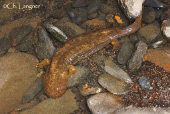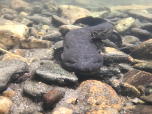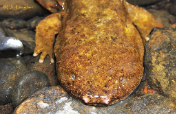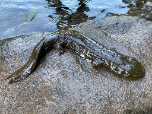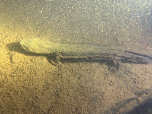|
Hellbender (Cryptobranchus alleganiensis)
Description: C. alleganiensis has a flat body and head, with beady dorsal eyes and slimy skin. Like most salamanders, it has short legs with four toes on the front legs and five on its back limbs, and its tail is keeled for propulsion. Their tail is shaped like a rudder, but it is rarely used for swimming; these salamanders use pads on their toes instead to grip rocks and walk up and down streams instead of swimming. The hellbender has working lungs, but gill slits are often retained, although only immature specimens have true gills; the hellbender absorbs oxygen from the water through capillaries of its side frills. Only occasionally leaving the water, the hellbender makes little use of these lungs and the juveniles lose their external gills after around 18 months Hellbenders use their lungs for buoyancy more than breathing. It is blotchy brown or red-brown in color, with a paler underbelly.
Both males and females grow to an adult length of 9.4 to 15.7 inches from snout to vent, with a total length of 12 to 29 inches, making them the fourth-largest aquatic salamander species in the world (after the South China giant salamander, the Chinese giant salamander and the Japanese giant salamander, respectively) and the largest amphibian in North America, although this length is rivaled by the reticulated siren of the southeastern United States (although the siren is much leaner in build). An adult weighs 3.3 to 5.5 lbs., making them the fifth heaviest living amphibian in the world after their South China, Chinese and Japanese cousins and the goliath frog, while the largest cane toads may also weigh as much as a hellbender. Hellbenders reach sexual maturity at about five years of age, and may live 30 years in captivity.
The hellbender has a few characteristics that make it distinguishable from other native salamanders, including a gigantic, dorsoventrally flattened body with thick folds travelling down the sides, a single open gill slit on each side, and hind feet with five toes each. Easily distinguished from most other endemic salamander species simply by their size, hellbenders average up to 60 cm or about 2 ft in length; the only species requiring further distinction (due to an overlap in distribution and size range) is the common mudpuppy (Necturus maculosus). This demarcation can be made by noting the presence of external gills in the mudpuppy, which are lacking in the hellbender, as well as the presence of four toes on each hind foot of the mudpuppy (in contrast with the hellbender's five). Furthermore, the average size of C. a. alleganiensis has been reported to be 45–60 cm (with some reported as reaching up to 30 inches), while N. m. maculosus> has a reported average size of 11 to 16 inches in length, which means that hellbender adults will still generally be notably larger than even the biggest mudpuppies.
Habitat: This aquatic species inhabits rocky, clear creeks and rivers that contain abundant cover in the form of large flat rocks, bedrock shelves, crevices, and logs. It usually avoids water warmer than 20°C. Males prepare nests and attend eggs beneath large flat rocks or submerged logs. This species breeds by larval development. This is a long-lived species, with a life expectancy of 20–30 years. The generation length is estimated to be 10 years.
Range: Hellbenders are present in a number of Eastern US states, from southern New York to northern Georgia,[24] including parts of Ohio, Pennsylvania, Maryland, West Virginia, Virginia, Kentucky, Illinois, Indiana, Tennessee, North Carolina, South Carolina, Alabama, Mississippi, Arkansas, Missouri, and extending into Oklahoma and Kansas. The subspecies (or species, depending on the source) C. a. bishopi is confined to the Ozarks of northern Arkansas and southern Missouri, while C. a. alleganiensis is found in the rest of these states.
Diet: C. alleganiensis feeds primarily on crayfish and small fish, but also insects, worms, molluscs, tadpoles and smaller salamanders. There seems to be a specific temperature range in which hellbenders feed, as well: between 45 and 80 °F. Cannibalism—mainly on eggs—has been known to occur within hellbender populations. One researcher claimed perhaps density is maintained, and density dependence in turn created, in part by intraspecific predation
Reproduction: The hellbenders' breeding season begins in late August or early- to mid-September and can continue as late as the end of November, depending on region. They exhibit no sexual dimorphism, except during the fall mating season, when males have a bulging ring around their cloacal glands. Unlike most salamanders, the hellbender performs external fertilization. Before mating, each male excavates a brood site, a saucer-shaped depression under a rock or log, with its entrance positioned out of the direct current, usually pointing downstream. The male remains in the brood site awaiting a female. When a female approaches, the male guides or drives her into his burrow and prevents her from leaving until she oviposits.
Female hellbenders lay 150–200 eggs over a two- to three-day period; the eggs are 0.71–0.79 inches in diameter, connected by five to ten cords. As the female lays eggs, the male positions himself alongside or slightly above them, spraying the eggs with sperm while swaying his tail and moving his hind limbs, which disperses the sperm uniformly. The male often tempts other females to lay eggs in his nest, and as many as 1,946 eggs have been counted in a single nest. Males also exhibit mate and shelter guarding. Studies have found that until the female successfully reproduces, the male hellbender will guard her in his territory until the reproduction is complete. Cannibalism, however, leads to a much lower number of eggs in hellbender nests than would be predicted by egg counts.
After oviposition, the male drives the female away from the nest and guards the eggs. Incubating males rock back and forth and undulate their lateral skin folds, which circulates the water, increasing oxygen supply to both eggs and adult. Incubation lasts from 45 to 75 days, depending on region.
Hatchling hellbenders are 0.98–1.30 inches long, have a yolk sac as a source of energy for the first few months of life, and lack functional limbs.
Status: Listed as Vulnerable because this species is in significant decline suspected to be between 30–50% over the past three generations (30 years - assuming a generation length of approximately ten years) due to the impacts of disease and widespread habitat loss and degradation throughout much of its range.
Subspecies: Two, both found in the United States:
Eastern Hellbender - (Cryptobranchus alleganiensis alleganiensis)
Ozark Hellbender - (Cryptobranchus alleganiensis bishopi)
»» Kingdom: Animalia - Animals
»» Phylum: Chordata - Chordates
»» Subphylum: Vertebrata - Vertebrates
»» Class: Amphibia - (Amphibians)
»» Order: Caudata - Salamanders
»» Family: Cryptobranchidae - Giant Salamanders
»» Genus: Cryptobranchus
»» Species: Cryptobranchus alleganiensis - Hellbender
This article uses material from the Wikipedia article "Hellbender", which is released under the Creative Commons Attribution-Share-Alike License 3.0. Content may have been omitted from the original, but no content has been changed or extended.
|
|




